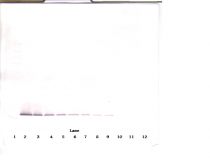ARG56824
anti-Endostatin antibody (Biotin)
anti-Endostatin antibody (Biotin) for ELISA,Western blot and Human
Overview
| Product Description | Biotin-conjugated Rabbit Polyclonal antibody recognizes Endostatin |
|---|---|
| Tested Reactivity | Hu |
| Tested Application | ELISA, WB |
| Host | Rabbit |
| Clonality | Polyclonal |
| Isotype | IgG |
| Target Name | Endostatin |
| Antigen Species | Human |
| Immunogen | E.coli derived Recombinant Human Endostatin. (MHSHRDFQPV LHLVALNSPL SGGMRGIRGA DFQCFQQARA VGLAGTFRAF LSSRLQDLYS IVRRADRAAV PIVNLKDELL FPSWEALFSG SEGPLKPGAR IFSFDGKDVL RHPTWPQKSV WHGSDPNGRR LTESYCETWR TEAPSATGQA SSLLGGRLLG QSAASCHHAY IVLCIENSFM TASK) |
| Conjugation | Biotin |
| Alternate Names | KS; KNO; KNO1; Collagen alpha-1(XVIII) chain |
Application Instructions
| Application Suggestion |
|
||||||
|---|---|---|---|---|---|---|---|
| Application Note | * The dilutions indicate recommended starting dilutions and the optimal dilutions or concentrations should be determined by the scientist. |
Properties
| Form | Liquid |
|---|---|
| Purification | Purified by affinity chromatography. |
| Buffer | PBS (pH 7.2) |
| Concentration | 1 mg/ml |
| Storage Instruction | Aliquot and store in the dark at 2-8°C. Keep protected from prolonged exposure to light. Avoid repeated freeze/thaw cycles. Suggest spin the vial prior to opening. The antibody solution should be gently mixed before use. |
| Note | For laboratory research only, not for drug, diagnostic or other use. |
Bioinformation
| Database Links | |
|---|---|
| Gene Symbol | COL18A1 |
| Gene Full Name | collagen, type XVIII, alpha 1 |
| Background | This gene encodes the alpha chain of type XVIII collagen. This collagen is one of the multiplexins, extracellular matrix proteins that contain multiple triple-helix domains (collagenous domains) interrupted by non-collagenous domains. A long isoform of the protein has an N-terminal domain that is homologous to the extracellular part of frizzled receptors. Proteolytic processing at several endogenous cleavage sites in the C-terminal domain results in production of endostatin, a potent antiangiogenic protein that is able to inhibit angiogenesis and tumor growth. Mutations in this gene are associated with Knobloch syndrome. The main features of this syndrome involve retinal abnormalities, so type XVIII collagen may play an important role in retinal structure and in neural tube closure. Alternative splicing results in multiple transcript variants. [provided by RefSeq, Dec 2014] |
| Function | COLA18A probably plays a major role in determining the retinal structure as well as in the closure of the neural tube. Endostatin potently inhibits endothelial cell proliferation and angiogenesis. May inhibit angiogenesis by binding to the heparan sulfate proteoglycans involved in growth factor signaling. [UniProt] |
| Calculated MW | 178 kDa |
| PTM | Prolines at the third position of the tripeptide repeating unit (G-X-Y) of the triple-helical regions are hydroxylated. |
Images (4) Click the Picture to Zoom In
-
ARG56824 anti-Endostatin antibody (Biotin) WB image
Western blot: 250 - 0.24 ng of Human Endostatin stained with ARG56824 anti-Endostatin antibody (Biotin), under reducing conditions.
-
ARG56824 anti-Endostatin antibody (Biotin) standard curve image
Direct ELISA: ARG56824 anti-Endostatin antibody (Biotin) at 0.25 - 1.0 µg/ml results of a typical standard run with optical density.
-
ARG56824 anti-Endostatin antibody (Biotin) WB image
Western blot: 250 - 0.24 ng of Human Endostatin stained with ARG56824 anti-Endostatin antibody (Biotin), under non-reducing conditions.
-
ARG56824 anti-Endostatin antibody (Biotin) standard curve image
Sandwich ELISA: ARG56824 anti-Endostatin antibody (Biotin) as a detection antibody at 0.25 - 1.0 µg/ml combined with ARG56715 anti-Endostatin antibody as a capture antibody. Results of a typical standard run with optical density.









